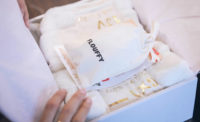Materials Technology: Packaging Design
Packaging Design Closes the E-Commerce Experience Loop
Three steps to point your e-commerce packaging in the direction of success.






E-commerce packaging is still evolving and finding its place within the online purchase loop. With new technologies streamlining checkout processes making every click count, brands are discovering the importance of packaging’s role in consumer happiness. Free returns being standard practice magnify the effect that poorly delivered experiences can have by increasing return rates and negative comments on social media — and take you from a 5-star to a 2-star product in no time.
We collaborate with many startups in search of the secret sauce to deliver memorable unboxing moments worthy of sharing on social media and creating a viral storm of press. The truth is: there is no secret, no algorithm and no sauce. Simply put, you have to envision the consumer experience and understand the needs and expectations of each brand’s target market. Every brand is different, so taking too much inspiration from others will only deliver an experience lacking in brand authenticity. Let your brand pillars do the heavy lifting and allow packaging to guide consumers through them.
The most valuable knowledge I can share is less about design and more about process, thinking and the value of working with the right team. Follow these three steps to point your e-commerce packaging in the direction of success.
Step 1: Understand the Process
In order to close the loop on the e-commerce experience you have to understand the process from start to finish.
First, what happens after the checkout is complete? How are orders filled? Are they manually pick, packed and wrapped, or is it an automated process?
Second, what’s the storage capacity for the distribution center (DC)? Should packaging be broken down and assembled prior to picking and packing? Can the DC store assemble packaging?
And third, identify inner dimensions required for the top three standard order volumes. You want to design for the top three order volumes in order to discover efficiencies and gain economies of scale in packaging production.
Answering these three points will provide a baseline for the needs packaging must solve prior to anything being shipped to consumers.
Step 2: Which Comes First, Structural or Visual Packaging Design?
Given our defined baseline in Step 1, we can move forward with designing the unboxing process. By understanding the entire process, structural packaging and visual design can solve the needs of each user in the loop, including the end user. But which comes first, structure or visual design?
Because experiences are consumed with our senses, unboxing begins with our eyes but quickly transitions to a physical interaction in our hands. For example, even the most beautiful clamshell packaging is still a clamshell requiring box cutters and bandages to deliver the product from its razor sharp clutches. So, without structural packaging as the wireframe to outline user interaction, it’s easy for brands to lose sight of the experience and focus on graphic design. We recommend beginning the design process with structure, identifying key interactions and defining the moments that can be accentuated by visual design. How a box is opened and a product presented, how layers of protection create the experience, and how many physical elements make up the unboxing are all answered with structure. All packaging design should be the result of a collaborative process between structural packaging and visual designers.
Step 3: Layered Unveiling
Now that we understand the differences between structural and visual packaging design, we move to the layers of the unboxing experience.
In reality it will be one to two days before the consumer interacts with your e-commerce packaging since the order was completed online. It’s important to consider this when designing an unboxing experience because the consumer has forgotten the seamless checkout experience. The momentum of the sale has stopped by now, and it is the packaging’s responsibility to reignite the romance for the brand. Due to security, the box exterior can be simple with brand notes to build anticipation such as taglines, icons or color. Remember that we’re delivering an experience, not Fort Knox, so make the pack frustration-free and easy to open.
The interior presentation must validate the consumer’s purchase and show respect for the product. Brands that fail to respect their product can’t expect consumers to value and respect their brand. Utilizing brand-appropriate colors, textures and visual packaging design within the pack is the first step in a well-crafted unveiling process. A layered unveiling will mean something different to each brand, but the goal is to create a thoughtful interaction that connects with the consumer and builds the anticipation for what’s inside. An inner box topper, tissue, or fabric cut and sew packaging is a great way to incorporate a moment of pause, and delay the final reveal. Using cut and sew in e-commerce packaging is a great way to deliver a keepsake item that can be reused and create a lasting impression on the consumer.
As with any packaging design, it’s important to prototype, test and refine. Make sure once the unboxing is complete that the number of packaging elements don’t outweigh the product purchased and deliver an onslaught of @overpackaged posts. There’s a fine line, and a team well versed in structural packaging can guide you through the process.
For more on e-commerce design, please visit Design Packaging at designpackaginginc.com.
Looking for a reprint of this article?
From high-res PDFs to custom plaques, order your copy today!










